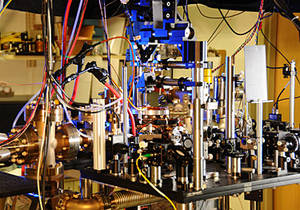 Researchers at the National Institute for Standards and Technology have built the most accurate clock ever made, accurate to one second in ten billion years...
Researchers at the National Institute for Standards and Technology have built the most accurate clock ever made, accurate to one second in ten billion years...
The clock works by precisely monitoring the frequency at which atoms of ytterbium naturally vibrate, producing light waves of very characteristic frequencies and colours.
The key to making any clock as accurate as possible is to build a system that ticks or vibrates at the steadiest frequency possible. In a pendulum clock, friction between the clock's parts and with the air around the pendulum bob interferes with its steady swing and make it swing unpredictably.
Atomic clocks, on the other hand, are able to achieve much better accuracy than clocks with larger swinging mechanisms, because it's much easier to put single atoms in very controlled laboratory environments, away from external interfering influences.
The difficulty, however, is that the electromagnetic vibrations produced by atoms typically have frequencies of billions, or even millions of billions, of cycles per second. Counting those cycles to keep track of time requires some of the fastest electronics in the world. Although ytterbium atoms are known to be very stable, it hasn't been possible to use them in an atomic clock until now because of the high frequency of the light they produce.
Using time standards like these allow scientists to make very precise measurements of how long processes take. For example, the Earth rotates on its axis once every 24 hours, and that is what gives us day and night. But movements of landmasses and ice sheets can trigger minute variations in the Earth's rotation, which can only be measured with the world's best clocks, but which can tell us about the structure of our own planet.
Physicists want to test Einstein's theory of relativity, which predicts that clocks should run slow when moved at very high speeds, but the effect is so tiny that it can only be measured with incredibly good clocks.










Comments
Add a comment